#thomas nickerson
Text
Very niche but one of my favourite characters are black boys that grow up in a slightly more comfortable environment compared to the world around them but because of factors out of their control their old world ends and they must make their own way in a brave new terrifying place. Through it all they hold on to their ideals and self with straining fingertips until they manage to share their burden with a family they create/find and flourish and thrive. Also they are the heart and moral compass of the group and they fight the oppressive system using slightly illegal methods and they're the outsider and they have a unique worldview because of how they grow up and how they survived and they advocate for the common people and they are the light and soul and and


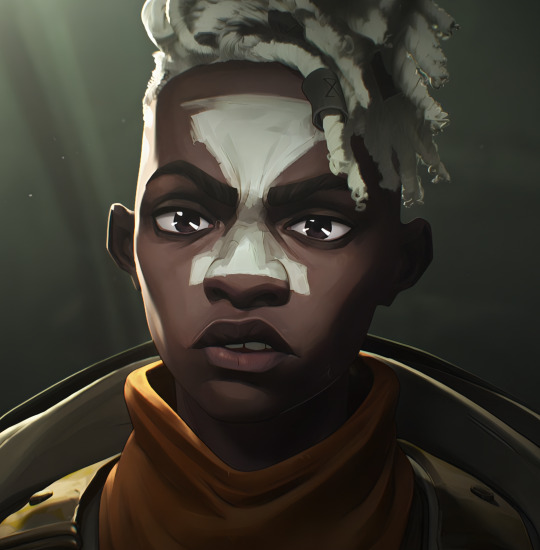
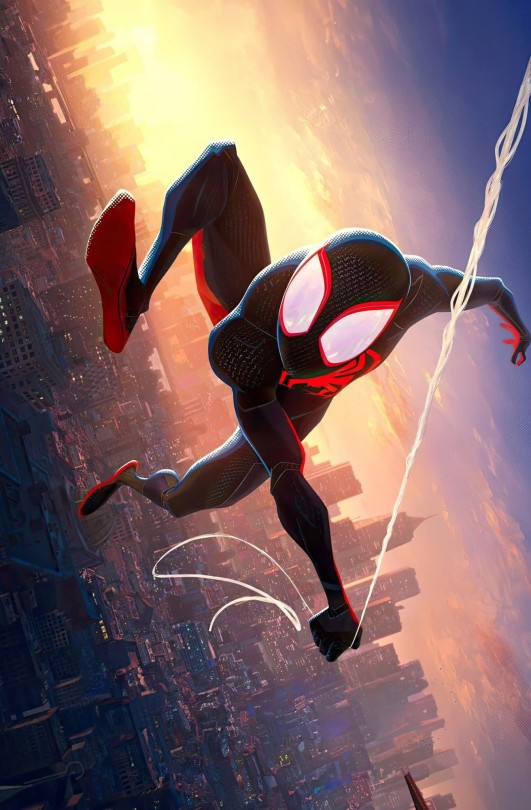
#ned nickerson#nancy drew cw#cw nancy drew#duke thomas#batfam#batman#the signal#ekko#ekko arcane#arcane#miles morales#spiderman#into the spider verse#across the spiderverse
381 notes
·
View notes
Photo

“Early house and store, possibly on Clay Street; dentist on second story” c. 1875. Photographer unknown (from the Marilyn Blaisdell Collection). The main signage at the second floor reads from right to left: 脱牙線牙專醫牙痛 (lit. “flossing dentist toothache specialist”; canto: “seen ngah chuen yi ngah tuhng”; pinyin: “tuō yá xiàn yá zhuān yī yátòng”). The sign seen above the railing at right indicates that, the dentist apparently shared the building with a photography studio 映相樓 (lit. mirror image building; canto: “ying sun lauh”), but the photographer’s name is undiscernible in the image.
A name is barely discernible above the main dental office sign. According to historian and author Roland Hui, the Chinese name 鄺慈敬 (Kwong Tse King....) [canto: “Kwong Tee Ging”] is the same name used by one the 1902 SF Dental College graduates, Charlie Fong. “Since 鄺 is pronounced "Fong" in Hoisanwa,” Hui asserts, “the dentist in the picture may well be Charlie Fong aka Fong Tse King.” Hui notes that the name “Charley Fong” appears in the 1894 Langley directory with an office address of 813-1/2 Sacramento Street. Given the steep angle of incline depicted in the photo, and the streetcar tracks in the foreground, a location on Sacramento Street represents another possible site for the photo.
The Unsung: Chinatown’s Trailblazing Dentists
The histories and storytellers of old San Francisco Chinatown often overlook the dentists who served the pioneer community. Chinese practitioners of dentistry must have inevitably followed the Gold Rush migrants from southern China to California. However, the historical record about Chinatown’s earliest dentists remains scant.
Dentistry had only recently separated itself as a medical specialization in the US in the latter part of the 19th century. On May 28, 1881, the medical faculty formally proposed the creation of an affiliated Dental Department to the UC Regents, using the affiliation of the medical and pharmacy departments as precedent. Part of their appeal included their promise of free lecture and clinic space for dental students at the Toland Medical College building.
The Pioneers
Coincidentally, the Langley directory of 1882 printed the first English language listing for a “Mar Yuet Wo, dentist, 1002 Dupont” in Chinatown. The address had been formerly occupied by the barber of the Globe Hotel, Mee Nguen, and since 1881 had also served as the address of the Tai Yuen Co. grocery store. Unfortunately, the historical record goes silent about Mar and any other dentists until 1894 and 1895 when the Langley directory lists dentists Charley Fong at 813-1/2 Sacramento Street and Carl M. Lee at 754 Washington Street.
By 1902, Fong, Lee, and two other Chinese had availed themselves of the western training provided by the San Francisco Dental College and obtained degrees of Doctor of Dental Surgery by May 20, 1902.

Announcement in the Pacific Dental Gazette listing the graduates of the San Francisco Dental College in its third commencement exercises of May 2, 1902.
Leung Ting Mai
By the time of his graduation as a western-trained dental surgeon, Leung Ting Mai had already been practicing dentistry under the name of “J.B. Landon.” Leung had been born in Hao-Shan, Kwangtung, in 1860. Chinese sources report that he arrived in the US in December 1876. After marrying in 1885, Leung began his studies in dental surgery for the next several years. The photographic record, however, suggests that Leung may have been providing dental services as Dentist Leung Ting 梁廷美牙醫 (canto: “Leung Tin Mei Nga Yih”) prior to his licensure in 1902.

A view of the northwestern corner of the intersection of Washington and Dupont Streets, no date, c. pre-1904. Photographer unknown (from the collection of the Bancroft Library). This corner building had two addresses on 900 Dupont and an entrance at 800 Washington, the doorway to which is seen at the left of the frame. Signage for dentist Leung Ting Mai can be seen on the corner of the building at the upper floor.
Whether by chance or calculation, the entrance to Leung’s dental office at 800 Washington was placed strategically to the left of a wall on which community news was posted, including tong death notices, what historian Phil Choy would later denote as a “murder wall.” As the next series of photos shows, the men of Chinatown’s bachelor society frequently gathered on the sidewalk outside of Leung’s dental offices.

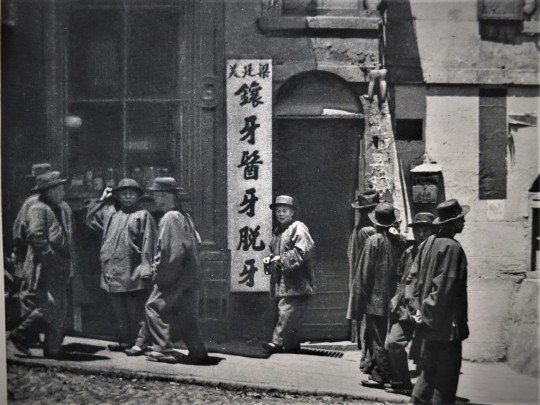
The entrance to 800 Washington Street and dentist Leung Ting Mei’s offices, c. pre-1904. Photographer unknown (from the collection of the San Francisco Public Library). The second photos represents one of several close-ups in the SFPL collection.
In addition to the photos taken by the unknown photographer whose work reposes with the San Francisco Public Library, the signage of dentist Leung Ting Mei, a.k.a. “J.B Landon” would be preserved for future generations as other photographers of old Chinatown photographed men gathered in front of the poster-wall at the northeastern corner of Washington and Dupont Streets. Whether by accident or design, Leung’s dental office signage would provide the most photographed dentist’s signage of old Chinatown.

“The Billboard in Chinatown” c. 1895-1904. Photograph by Grahame H. Hardy (from the collection of the California State Library). A group of Chinese men read wall posters and news in Chinatown outside the entrance of 800 Washington Street. The small awning for “J.B. Landon Dentist” appears in the upper left-hand corner of the frame.
By the turn of the century, and certainly by 1902, Leung had changed his purely Chinese signage and settled on conducting his dental practice under the name of “J.B. Landon” for reasons that are now lost to memory. If Leung Ting Mar intended the ploy to avoid a marketing stigma of a Chinese name and gain a listing in the main body of the Langley business directory, it appears to have worked. Both the 1904 and 1905 Langley directories list “Landon, James B, dentist, 904 Washington” during a time when racial prejudice against the Chinese was running high and the Langley directory had omitted its separate section of Chinatown business listings.
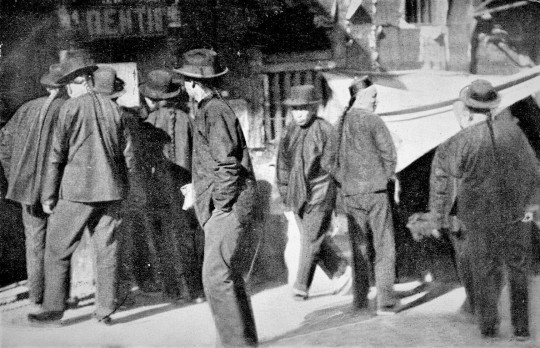
Another photo of men reading wall postings below the dental office signage for dentist Leung Ting Mar, doing business as “J.B. Landon, Dentist” c. 1904-1905. Photographer unknown.

“Five Chinese men with queues reading a wall poster, San Francisco Chinatown,” c. 1900. Full credit: Pictures from History / Granger, NYC -- All rights reserved.

Group of men reading news and wall notices outside the office of J.B. Landon Dentist, c. 1904-1905. Photographer unknown (from the collection of the San Francisco Public Library).
The photos in the Granger and San Francisco Public Library collections represent perhaps the best images of the complete dental office signage for dentist Leung Ting Mar, practicing dentistry under the name of “J.B. Landon, Dentist.”
As with every other business in Chinatown, the building in which Leung practiced dentistry was destroyed in the 1906 earthquake and fire. According to Chinese sources, Leung returned to China in August, 1906 where he opened a dental practice that year in the Mission Building located on the Bund in Guangzhou. His years of dental practice in San Francisco’s Chinatown, however, would be immortalized in its photographic record and its derivative colorized print and postcard art.
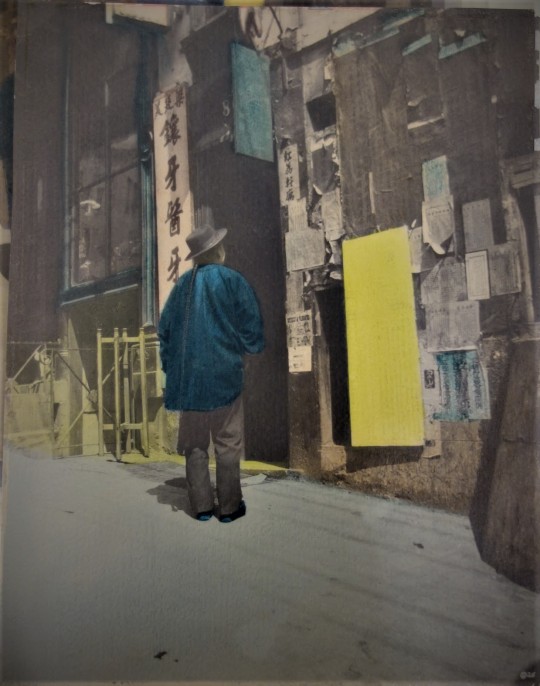
Colorized postcard of a lone man reading wall notices outside the dental office of Leung Ting Mai at 800 Washington Street. Photographer unknown (from the collection of the California Historical Society).
A Chinese American Original and a First: Faith Sai So Leong

Formal portrait of Faith Sai So Leong (from the collection of her sons Edwin and Eric Owyang).
While the first wave of western-trained dentists practiced in Chinatown, San Francisco dental colleges had continued to admit more Chinese students. In 1904, Faith Sai So Leong (蔡世良; canto: “Cheuih Sai Leung”) became the first woman to graduate from the College of Physicians and Surgeons (now the University of the Pacific Arthur A. Dugoni School of Dentistry).
Born in China, she came to San Francisco in 1894 at the age of 13. She was adopted as “Sai So Yeong.” by Mrs. E J Nickerson, an English teacher, in San Francisco’s Chinatown. Nickerson would help Sai So learn English and would arrange for Sai So to be baptized with the Christian name “Faith” at Grace Church.
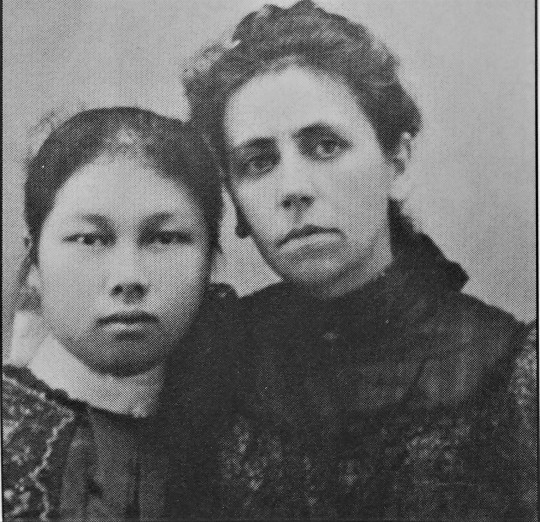
Faith Sai So Leong with her adoptive mother, Mrs. E.J. Nickerson, in San Francisco, c. 1894. Photographer unknown (from the collection of Edwin Owyang, MD).
Having been encouraged to pursue dentistry by a cousin who was also a dentist, Faith entered dental school and graduated when she was 24 years old. She was awarded the Doctor of Dental Surgery in 1905 from the College of Physicians and Surgeons, San Francisco, May 18, 1905 at the Alhambra Theater, San Francisco.

The 1904 graduation photo of Faith Sai So Leong (a.k.a. Sai So Yeong).
However, the issuance of her license was delayed due to an investigation and trial related to misconduct by members of the State Board of Dental Examiners. In August 1905, Faith Sai So Leong was the only woman out of a class 40 students to receive a dental license.

The San Francisco Call, August 12, 1905, p. 5. In column five, the paper reports without fanfare that “Miss Faith Sai So Leong, San Francisco,” the first Chinese woman to receive a dentist license in the US, was among the group of new dental licensees for that year.
Faith Leong initially established her dental practice at 847 Dupont Street in San Francisco’s Chinatown, primarily serving the Chinese. After the 1906 San Francisco earthquake and fire destroyed her office and laboratory, she relocated to Oakland.
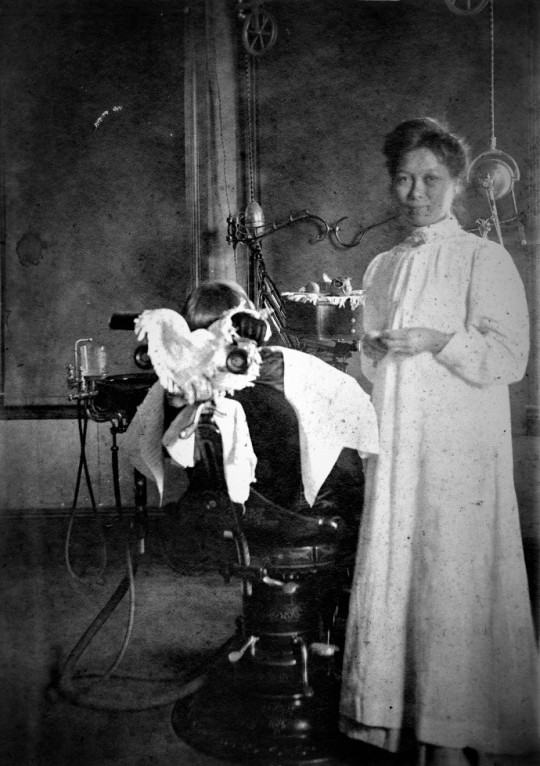
Dr. Faith Sai So Leong posing with a patient in the examination chair. Photographer unknown (from the collection of descendants Edwin and Eric Owyang).
Historian Thomas W. Chinn wrote in his book Bridging the Pacific about her resumption of dental practice in Oakland as follows:
“It took a while, but on July 23, 1906, she found quarters at 8th and Harrison streets in Oakland, where she reestablished herself. In a short time or practice was flourishing again. Her greatest loss from the fire, she considered, was a loss of her college diploma, and though a duplicate was soon secured, it was not quite the same. . . .

The Affidavit signed by Faith Sai So Leong on May 8, 1907, applying for a duplicate diploma to replace the original one destroyed in the 1906 fire (from the collection of the University of the Pacific).

A feature story about “The Only Chinese Woman Dentist” Faith Sai So Leong, in the San Francisco Sunday Call of September 15, 1907.
“Now there was a steady stream of patients to and from her office: men, women, and children, wealthy merchants and community leaders – all to be examined and taken care of by ‘a slight slender girl enveloped in a long white apron, definitely manipulating the bright instruments and tinkering among her laboratory paraphernalia while one of her countrymen occupies our big dentist chair,’ as one visitor described her.”

The Chinese Dentist Club, San Francisco, c. 1909. (Photo courtesy of Edwin Owyang, MD) Dr. Faith Leong Owyang served as the club’s treasurer. Charley Fong, whose Chinese name (鄺慈敬) appears 4th from the right of the photo, appears to use the same Chinese name which can be seen above the main dentist’s sign in the first photo shown in this article.
In 1909, Leong married Nam Owyang, the son of the secretary to the Chinese Consul to San Francisco. The two had met during her vacation in Hong Kong. She returned to San Francisco on August 5, 1910. By the following month, Faith Leong Owyang, DDS, re-opened her practice in Chinatown at 1108 Stockton Street. She also joined the Chinese Methodist Episcopal Church.
She would later bring her aging former guardian, Mrs. Nickerson, to live with her family. She gave birth to two sons, Eric and Edwin. She would also bring her aging former guardian, Mrs. Nickerson, to live with her family.
The life of this trailblazer among Chinese American women was tragically cut short at age 47 when a runaway vehicle on Grant Avenue struck her as she helped her son avoid the impact. She was taken to Harbor Emergency hospital suffering from multiple fractures and internal injuries. She passed away in San Francisco on May 10, 1929.

Dr. Faith Sai So Leong posing in formal Chinese garb. Photographer unknown (from the collection of descendants Edwin and Eric Owyang).
She is remembered today as the world’s first modern-trained Chinese woman dentist in the world.
Charles Goodall Lee
If Charles Goodall Lee (1881 – 1973) had done nothing more than pursue his studies to become the first licensed Chinese American dentist in California, he would be remembered today. Lee, however, also exemplified the small second generation of Chinese Americans committed to perfecting their civil rights in the US
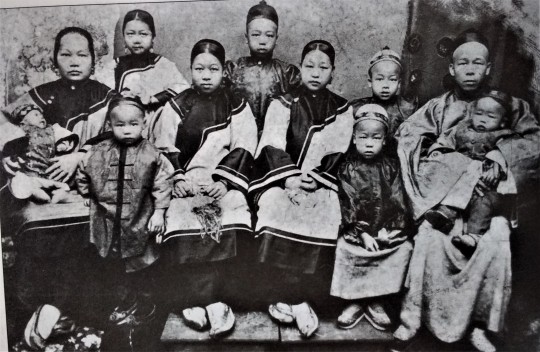
An 1891 photo of the family of the future dentist, Charles G. Lee (back row, center), the first Chinese American licensed to practice dentistry in California. According to journalist William Wong, Lee’s son, Lester, would also become a dentist. (Photo courtesy of Mary Mar)
Lee was born in 1881 on the eve of the Exclusion Act in San Francisco, California, to Lee Tong Hay, a lay leader helping to organize the Chinese Methodist Church with Otis Gibson's missions that would become the Chinese Community United Methodist Church. After graduating from the School of Dentistry at University of the Pacific, Lee established his dental practice in San Francisco’s Chinatown.

“Chinatown - Dupont Street at Clay Street, April 9, 1900.″ Photograph by D. H. Wulzen from the D. H. Wulzen Glass Plate Negative Collection (Sfp 40), San Francisco History Center, San Francisco Public Library. The balconies of the Woey Sin Low restaurant at 808 Dupont appears to the left of the frame in the above photograph. The signage for the dental office of “Charles S. Lee” [sic] can be seen at street level (806 Dupont) and the corner of the building.
After the 1906 San Francisco earthquake, Lee relocated to first to San Jose, California, and later settled in Oakland, becoming one of Oakland Chinatown's first dentists. He continued his dental practice until his retirement in 1940, but, along the way, actively participated in civic affairs.
He co-founded Oakland's Chinese American Citizens Alliance in 1912 and co-financed the construction of CACA’s lodge in Oakland. Lee reportedly contributed the largest payment for the purchasing of the building as well as the repair fees. As a member of the Oakland Lodge, Lee fought for the civil rights, equal economic and political opportunities, and the general welfare of Chinese Americans.
He was married to a fellow civic activist, Clara Elizabeth Chan. who was the first Chinese American woman to register to vote in the United States.

A smiling dentist Charles Goodall Lee (center) accompanied his wife Clara Elizabeth Chan Lee (second from right) and teacher Emma Tom Leung (left) of OakIand to the Alameda County Court House on November 8, 1911. According to the Oakland Tribune, the women became “the first ethnic Chinese women in history to become eligible to vote when they registered. Assistant County Clerk W.B. Reith supervised their application while Tom Leung and Charles G. Lee looked on.
Lee was also a lay leader of the Chinese Community Methodist Church of Oakland, a member of the Oakland Chinese Center, and a member of the Lee Family Benevolent Association.
Next generation activists
The life of Thomas Wai Sun Wu, exemplified the continuance by the next generation of the trail blazed by the pioneer dental practitioners.
Born in 1915 in San Francisco, Wu taught himself to play the piano when his sisters started lessons. His musical abilities progressed to the point where he played at the True Sunshine Episcopal Church, founded by his father, the Rev. Daniel Wu.
“In the 1930s, he helped organize a dance orchestra, the Chinatown Knights, and was a rehearsal pianist for orchestras visiting San Francisco,” reporter Vanessa Hua wrote. “At the time, he was not allowed to perform in public because he was Chinese, and when he tried to join the San Francisco musicians union, he was rejected, he told his daughter, Laurene Wu McClain. Dr. Wu was able to get into the Sacramento union and play professionally.”

Dentist and civic leader Thomas W.S. Wu, DDS.
In 1939, Wu received his degree from UCSF Dental School and started his dental practice in Chinatown. He also found the time for civic, professional and religious organizations. Wu’s political advocacy would lead to San Francisco mayors appointing him to serve on the San Francisco Library Commission, Board of Permit Appeals, and the Art Commission. He also co- founded the Chinese Historical Society of America and served as president of the Eng Family Association. Later in life, he also on the board of On Lok Senior Health Services, the Chinatown YMCA and the Chinese American Citizens Alliance.
The largely unsung history of Chinatown’s first dentists illustrates the powerful effect exerted by the early and critical opening by San Francisco’s early dental schools to Chinese American students, those students rise to prominence as community professionals and leaders, and their activism informed by their faith.
Their day may begin when your pain starts, but the dentists of Chinatown have played their part in the progress of Chinese America toward the better future.
[updated 2023-2-22]
#Dentists of old Chinatown#Leung Ting Mei#Leung Ting Mar#J.B. Landon Dentist#Carl M. Lee#Charley Fong#Faith Sai So Leong#Sai So Yeong#E.J. Nickerson#Chinese Methodist Episcopal Church#Charles Goodall Lee#Clara Elizabeth Chan Lee#Thomas Wai Sun Wu DDS
3 notes
·
View notes
Text
Music on Whaleships
Because how else will you power through the boredom AND the horrors!?

Two men aboard the Wanderer, photographed by Pardon B. Gifford in 1906 (New Bedford Whaling Museum)
Music featured quite frequently on whalers, though not necessarily in the same way as it might on a merchant vessel. The quintessential musical contribution of sailors—the sea shanty—didn’t hold as prominent a place aboard a whaler as it did on other types of ships. Some captains were particularly strict about keeping noise down while cruising to prevent gallying any nearby whales. Shanties were also less necessary for performing the work: Whaleships tended not to carry a great deal of sail, had a lot of hands aboard available to handle it, and were quite leisurely in their pace as they lolled around the globe for years at a time. This was unlike merchant ships that tended to have smaller crews, larger ships, and tighter schedules, all for which shanties were used more often to coordinate that work effort.
However, music was still vital to maintaining good morale during a whalers' work that was, in turns, extremely demanding and dangerous, and extremely dull and mind-numbing. Both of which could really plague a fellow's soul if there was no relief. A panacea for a whaleship's ills, music rang out in the fo'c'sle during idle hours, was sought out during shore leaves, was copied down in remembered songs in the backs of men's journals, and any fellow who hazarded to pick up an instrument or lift his voice was a prized member of the crew.
Read on, under the readmore, since this is also quite a long one with many a photo, journal entry, recorded music, and whalers' original written songs! I really REALLY enjoyed pulling this one together.
Even though they weren't as utilized, there were still occasions when shanties burst out on deck. Greenhand William Abbe of the Atkins Adams (1858) recalled them first being used several months into the voyage. This speaks to the fact that shanties weren't a regular part of whaling work, but rather an instance of one shipmate finally venturing to include them:
“We began to sing shanties last night in hauling aft sheets or bowsing on halliards — Jack leading in 'Johnny Francois' + 'Katy, My Darling' and all hands taking up the refrain + pulling with a will. This pleased the Mate who told us that pretty well for the first time that he liked to hear us make a noise—as it showed that Jack —not Allegany [surname of a crewmate on board] — but any one of us was awake. He laughed—waved his hands— + cried out 'that’s the way sailors'.”
youtube
Johnny Francois, aka Boney
They were later "obliged to avast singing + haul away without the "Shantie" as the crew’s singing was so "ludicrous" that they were all laughing over it rather than effectively hauling. But even if shanties weren’t often used aboard the Atkins Adams to set the pace of the work, they still featured during downtime in their watches:
“Jack leading sung the watch out in Shanties 'Johnny Francois' 'Santa Anna' 'Katy, My Darling' +c. Mr. Gorland + Tripp came forward and joined us. It was very cold and wet — but our singing warmed our hearts while we were free from the spray and warm from mutual contact.”
On whaleships, shanties were more frequently employed—though still inconsistently—during more demanding tasks such as weighing anchor or working the windlass to haul up blubber.
While greenhand John Perkins’s ship, Tiger, was lying at anchor at the Hawaiian islands in 1845, he mentioned hearing another whaling crew strike up a shanty upon leaving:
“When called this morning we heard the Neptune’s crew weighing anchor to the tune of ‘Tally hi o you know.’ After breakfast our watch went ashore on liberty”
youtube
Tally-I-Oh
Music was also greatly sought out during whalers’ shore leave. Thomas Nickerson, cabin boy of the ill-fated Essex, 1820, wrote about a dance hall in Talcahuano that he was quite unimpressed by, but his other shipmates enjoyed tremendously.
"There we found a few young women seated around the hall on wooden stools, and playing off some Spanish airs upon their guitars to dance by. There did not seem to be either melody or music in their touch, but after such an interval of confinement our men were ready to dance to anything had it even been a corn stalk fiddle. With their guitars were an accompaniment of an old copper pan used as a tambourine. To this music did our men dance apparently with as much satisfaction as though it had been the finest music in the world.”
Music was also one of the first ways whalers and locals at various ports of call built camaraderie between each other, where potential language barriers were no object if someone had along with them a fiddle (and maybe some alcohol). Such an interaction was recorded by Albert Peck, greenhand on the Covington that stopped in Guam in the 1850s:
"Having our fiddler with us, we went from one hut to another giving them a tune at each, which would please them very much, and to show their appreciation of it they would produce a bottle of aquadiente [Aguardiente] or brandy, and treat us to a glass which would consist of a coconut shell, until it became evident that this would not do if we intended to walk to the town, as before long we should be incapable of walking anywhere. So we started for the town."
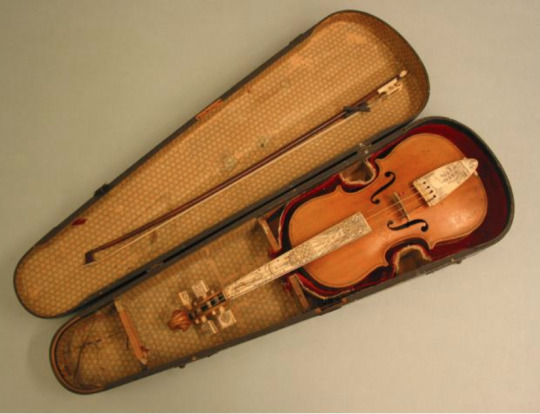


Whaler-made fiddle c. 1835-50, inscribed with the name Daniel Weeks. (New Bedford Whaling Museum)
But liberty always came to an end. When the Tiger departed Hawaii 10 days later, Perkins noted that they were too glum to accompany their leaving with a shanty:
“We weighed anchor without a song all feeling to bad at departing from summer islands to the cold Norwest sure of hard labor, absolute suffering & danger.”
Amidst that hard labor, absolute suffering, & danger, music served an essential function of bringing in levity and acting as a pressure release valve aboard.
Clifford Ashley, who joined the bark Sunbeam in 1904 on part of her voyage for research, described the music of his dog watch:
"Two misfit concertinas every night sent up their dismal wail to a tune that never varied, often keeping time with the strokes of a couple who pounded up hard bread in a canvas bag to be mixed into a molasses mush for their watch."

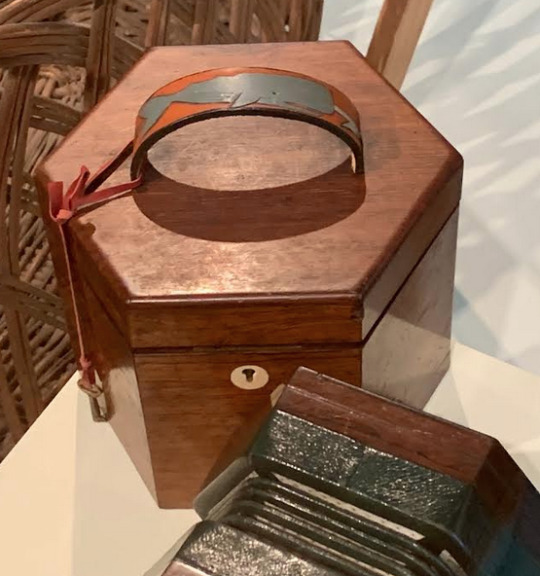
A whaler's concertina, c. 1850 (Nantucket Whaling Museum)
Any man who had a bit of a voice or could play a bit of an instrument quickly became a favorite among the crew, even if he only knew one song. Foremast hand William Stetson, of the Arab (1850s), was delighted when a new man they shipped aboard during a provision stop had some faint musical inclination.
“in the dog watches we enjoy ourselves very agreeably by stepping off a lively measure to the tune of “roads to Boston” as performed on the violin by Moody, one of those lately shipped at Lahaina. This is about the only tune he can saw off decently, but he is the first that has belonged to the bark this voyage who has made any pretensions to being a fiddler, and consequently the ‘doleful music’ of the skipper’s cracked violin is usually heard in the evening between the hours of five and seven P.M"
youtube
Moody's go-to, Road to Boston.
Even in the absence of an actual musical instrument, crews made do with whatever they could get. William Abbe writes about one such time on the Atkins Adams:
Last night while gamming with F. Willy in the forecastle I was called on deck to help make up a set for a cotillion — being honored as the lady of Curly — we were at a loss for music + were stepping to the hummed air of Johnny the Boatsteerer + the orders of the dancing master — Jack — when Shanghai rushed up from the forecastle + jumping up on the oil cask looked forward of the windlass + squatting his long legs on the cask head began a toot toot on an old tin funnel, followed by Johnny Come Lately on an old tin bread pan for a drum — We greeted our band with shouts — + to the music of our mimic french horn and kettle drum chased up + down + joining hands by partners promenaded with double quick steps round the forecastle deck making the deck ring with our laughter — + the rattling music — both music and steps getting quicker + quicker till Tarpsechorz [Terpsichore] herself would have fled agast — + home belles and beaus would have fainted at the sight —our fun was suddenly interrupted by the order to shorten sail — + our quick stepping was only rivaled by our agility aloft for we reduced sail in unusually short time.
The captain, enjoying their sense of play but finding their makeshift music particularly disagreeable, then came up on deck to give them something to better it:
“Old Man liked the fun but didn’t like the music for Old Woman — brot up on deck a new accordion + calling Charley aft consigned it to him with the injunction to use it well — Charley came forward — delighted— + mounting the spars struck up Fisher’s Hornpipe + the strums sounding through the calm evening animated us till Jack or Molly [a crewmate currently crossdressing for the role] + our barefooted stepping got the whole Ship’s Company in a roar — from the Old Woman to Cabin Boy.”

Crew members of the Charles W. Morgan, 1906, taken by Pardon B. Gifford (New Bedford Whaling Museum)
Sometimes music was a little less favorably received. J.T. Langdon, greenhand on the St Peter, 1840s-50s, had brought his fiddle aboard to entertain himself, and at one point taught the Captain how to play it. On the homeward bound stretch--with his patience with the job and everyone on board strained to the limit--he grumbled about music-making halting getting home quickly:
"There seems to be an little disregard to sailing the vessel on the part of the Captain and the Mate. The 'Old Man' will saw away on his 'old fiddle' and the mate will tinker and the ship goes where she likes. I have sometimes almost cursed the day that I learned the Cap'n to fiddle."
Sometimes, sailing be damned, it was time for an entire musical production, as on veteran whaler John Martin's ship, the Lucy Ann, 1841. He wrote out the Program along with the nicknames of the performers.
"We finished this day with a grand concert given by the whole crew. The audience were sea gulls. The following is the programme of the concert.
Programme
Part 1st
Song. One eyed Riley With chorus by whole crew. - By Chub.
"There was a Sheppards daughter, Kept sheep on yander hill" - by Lightning
Song. I hit her right on her stinking Machine - by Hominy Head
Solo. On Kent Bugle by - myself
Part 2nd
Song. Cant you wont you stay a little longer - by Turpin
"Turkish Lady - Black Leg
Duette with Drum & Fife - Chub & [left blank]
Part 3rd
Song. My dogs eyes makes mince pies - Steward
"Morgan Ratler - Spunyarn
"The Meremaid in three parts by - Hardy
"Trayum with chorus by crew
Part 4th
Song. Kelly the Pirate - King David
"Tally ho - Spunyarn
"Lord Lovell that went strange, countries for to see - Hardy
Solo. on flute by - Young Norval
Part 5th
Song. Fanny Blair - Turpin
"French Lady - Mizen
"All the girls in our town - Steward
Part 6th
Song. So early in the morning, the Sailors love the bottle O. - by Mocho a color'd Gentleman
"Milkmaid - Hominy Head
"Two little sisters walking up the street" - Jersey
Grand Chorus by the whole Crew on Bugle, Drum, Fife, Flute, Violins, Triangles, &c. & wound up by The mate telling us if we did not quit making such a damned noise he would heave a bucket of stinking water over us. Ends the same.
An excerpt of John Martin's above program:

Often, in the backs of journals whalemen would write songs that are still known today. Rolling Down to Old Maui, Blow Ye Winds, Coast of Peru, Homeward Bound, Saucy Sailor, etc. These were learned on the job, or exchanged between crew mates.
From the journal of William Buel of the Wave, 1856, the lyrics to Saucy Sailor which he learned from a fellow greenhand:
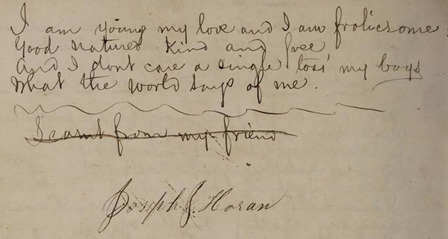
"I am young my love and I am frolicsome
Good natured kind and free
And I don't care a single toss my boys
What the world says of me
~~~~
Learnt from my friend
Joseph F Horan"
There's something quite lovely to having a shared thread from their lives into the present. We might be separated by a gulf of over a century, but we know the lyrics to the same songs.

Some whalers composed their own songs, too. I'll close with one written by career whaleman Joseph Dias, when he was captain of the St. George in 1853. He ended his lyrics with the note 'Read and Circulate', so I see it as my duty to do him a small kindness 170 years later by circulating it now.
Paradox
Come all ye shipmates lend an ear
And the truth you soon shall hear
Of the Ship St. George in the zealous sea
Who is raiseing hell it seems to me
—
The way we try to get our grease
So to strike three whales and save a piece
Beside two whales of india ruber
The boatsteerer swore to be slack blubber
—
Very poor advice I freely lend
Of a way I highly recommend
To take a crowbar and punch a hole
Drive in the iron and the pole
—
Hang to your line till all is blue
Either kill him or he kill you
We want a man upon the docket
To go ahead like david Crockett
--
Promoting men at our expense
Takes our dollars with our pence
Besides it throws our work away
This thing For sure will never pay
—
To see the whales was once the cry
They are here where e're you turn your eye
They have raced for rise to sitting sun
Been on a dozen and killed but one
—
To man that’s taught in a bowhead school
Will find himself here but a fool
Read and Circulate

493 notes
·
View notes
Text
#tumblr polls#marvel#mcu#spiderman#peter parker#tom holland#arvin russell#todd hewitt#danny sullivan#in the heart of the sea#the current war#cherry 2021#nathan drake#pilgrimage#the lost city of z#edge of winter#the impossible#wolf hall#marvel multiverse#mcu multiverse#Tom Holland filmography
13 notes
·
View notes
Text
What Happened to Novelist Barbara Newhall Follett?

November 6, 2023
Barbara Newhall Follet was born in New Hampshire on March 4, 1914 to literary editor, Wilson Follett and children's writer, Helen Thomas Follett. Barbara had one older sister from her father's first marriage, Grace, and a younger sister Sabra, who later became the first woman to become a graduate student at Princeton University in 1961.
Barbara was homeschooled by her mother and at a young age began her love for reading and writing. At age 4, Barbara was writing her own poems, and by age 7 she was writing about a world she created called Farksolia and writing about it's language, called Farksoo.
In 1923, as a birthday present for her mom, Barbara began to write a story called The House Without Windows with a typewriter she had been given. Later on, the manuscript actually burned in a house fire, but Barbara completely rewrote it and her father published it in 1927 as he was an editor for Knopf publishing house.
Due to the success of the book, which was about a young girl who ran away from home and lived in nature with her animal friends, some considered Barbara a child genius. Barbara began to review other children's books and her book was critically acclaimed by the New York Times.
Barbara's next book was called The Voyage of the Norman D, based on her experience travelling on a coastal schooner in Nova Scotia, Canada. This was published in 1928.
Though another success, 1928 would not be a good year for Barbara. Her father left her mother for another woman, and this was incredibly devastating to Barbara who was very close with her father.
Her family was then struggling and the Great Depression of the 1930's only made it worse. At the age of 16, Barbara took up a job as a secretary in New York City, writing several manuscripts.
Barbara met a man named Nickerson Rogers in 1931, and together, the two of them travelled to many different places in the world including the Appalachian Trail and also Spain. The couple settled in Brookline, Massachusetts where they married in July 1934.
Barbara was still writing, however she was not having much success with publishers. By 1937, her marriage wasn't so happy anymore either, she began writing to her friends about being dissatisfied with married life.
Her marriage began to crumble further, as Barbara had suspicions that Nickerson was being unfaithful, causing her to fall into a depression.
Barbara's husband stated that on December 7, 1939, Barbara had lelft their apartment after they had gotten into an argument. Nickerson said that Barbara had $30 in her pocket and she was never seen again.
Initially, Nickerson had not reported his wife as a missing person until two weeks later, telling police he was waiting for her to come home. Four months after Barbara's disappearance, Nickerson requested a missing persons bulletin be issued.
The bulletin had actually used Barbara's married name of Rogers, so the public had actually not recognized or known about her disappearance until 1966.
Thirteen years after Barbara disappeared, in 1952 her mother wanted the authorities to look more into it, believing that Nickerson had something to do it due to him putting in very little effort to find his wife.
Barbara's body was never found, and there was no evidence authorities could find suggesting or excluding foul play.
In 2019, a theory that Barbara's body was found but incorrectly identified was brought forth by a writer named Daniel Mills. Mills supposedly found evidence that Barbara's body was found in 1948, but identified as another missing woman named Elsie Whittemore.
The body was found on Pulsifer Hill, half a mile from where Barbara and Nickerson had a rental agreement. The possessions found with the body were consistent with Barbara's belongings, but local police were unaware of her disappearance. The cause of death was determined to be suicide, a bottle of barbiturate residue was found at the scene, which Barbara had been known to take.
10 notes
·
View notes
Text
Whale Weekly - Nov. 21
Chapter read: Nov. 23.
I made the spur of the moment decision to introduce myself to Moby Dick by reading it aloud to myself, and I’m glad I did. The text is so astonishingly meditative and easy to read (though, admittedly, not so easy to parse) that the ebb and flow of my own voice while reading gave me a superb sense of ease.
I doubt very much that Melville would have put any thought into iambs, but the meter within the sentences was like a melody.
While some authors use their writing to stick you in a specific place and time so you can watch the characters move through the world, Melville successfully drops you into what it is like to be Ishmael. The careless admission of depression, the deep longing for the sea... It’s all there on the page in a way I did not expect from a text published in the 1800s.
Makes me want to ride my bike out to the harbor to watch the night’s waters churn.
On a completely unrelated note, the release of Whale Weekly reminded me that an old friend gifted me a copy of The Loss of the Ship Essex, Sunk by a Whale in 2018. I had expressed an interest in taking my school’s class on Moby Dick my senior year of college and he very kindly gave me his copy of the companion text assigned in by the professor.
The book contains multiple first-person accounts, several of which have been published before. What draws me to it is that the text brings side-by-side to accounts, that of Owen Chase (the first mate who’s published account inspired Herman Meville) and that of Thomas Nickerson.
Nickerson was only 14 when the Essex was attacked and sunk by a whale in 1820, and his account would not be discovered until 160 years after the incident.
So, I gotta say, I’m excited to read it alongside Whale Weekly.
25 notes
·
View notes
Text
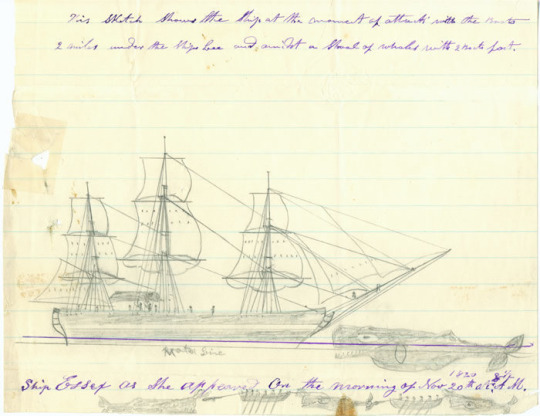
Essex being struck by a whale on November 20, 1820 (sketched by Thomas Nickerson)
#The Essex#whaleship Essex#Essexposting#I have been trying to find a post of the sketch and I could not#so I figured why not post it myself#link just goes to the wikipedia article I got the pic from#sketch is in public domain but photo source is always good to have#we are nearing the end of the Essexposting I swear
4 notes
·
View notes
Text
Ramblings: Tom Holland's career
I'm going to do a couple of other posts about Insomniac's Spider-Man 2, I played it the week it came out and I've just been watching clips and videos and I loved it. But anyway, this is about Tom Holland.
So, I've been of the opinion that while Tom is a fantastic actor, he keeps choosing projects (or his agent is) that he's either too good for, or the writing for them is less than stellar.
So here is a list of his films that I've seen. I haven't seen The Crowded Room but I heard it wasn't good but that Tom was good in it, which isn't surprising, story of his life I think.
The Impossible Lucas Bennett - First live action film, he's fantastic in this, should have been nominated. Made me cry.
How I Live Now Isaac - Weird little movie but he's good in it. Also made me tear up.
In the Heart of the Sea Thomas Nickerson - I forget about this one but he's fine it, the movie is fine.
Captain America: Civil War Peter Parker / Spider-Man - His Spider-Man debut and though he has a small part, he's great. Great debut.
The Lost City of Z Jack Fawcett - He plays the older version of the son and it's sad what's implied that happens to them but he's fine in this. His little mustache though had me cackling.
Pilgrimage The Novice / Brother Diarmuid - This movie is interesting and good and he's very good in it. Apparently while filming this, he and Jon Bernthal were sending in their tapes for Spider-Man and The Punisher lol.
Spider-Man: Homecoming Peter Parker / Spider-Man - Great solo film, felt like a John Hughes movie wrapped in comic book pajamas. I really love his suit, I guess we call it the "Stark Suit" since in the games, that's what it's called.
The Current War Samuel Insull - I don't remember him in this movie at all.
Avengers: Infinity War - Loved him in this, still wish he got to interact with Steve more than he did. I don't like the Iron Spider suit that much, but his scene with the snap was great, they knew who they had and capitalized on it.
Avengers: Endgame - Not in this one as much as IW, but I liked the scene where he has the gauntlet and he says "Hi, I'm Peter Parker" and Carol is like "Hey Peter Parker..."
Spider-Man: Far From Home - I feel like people are really hard on this movie, I love it. It was my fave Spidey movie for a while. I really loved the whole Mysterio thing. There are some things I might have wanted done differently but I overall loved it. I also love his Upgraded Suit and I liked how he used his intelligence to fight at the end.
Spies in Disguise Walter Beckett - I thought this was cute, it was fun and he does a great job with voice acting.
Dolittle Jip - the movie was not good and his role is small, but the voice acting was fine.
Onward Ian Lightfoot - Cute movie, made me tear up, the voice acting was really good. Love the brother relationship in this.
The Devil All the Time Arvin Russell - This should have been a mini series but he's good in it.
Cherry Cherry - Not a good movie but he's fine. He does despair very well lol.
Chaos Walking Todd Hewitt - Not a good movie, lots of potential, might have worked better as a tv series since it's a book series. Also, should have been made in the boom of YA dystopian movies or maybe now thanks to The Ballad of Songbirds and Snakes coming out. But he's fine it.
Spider-Man: No Way Home - Great movie, really fun, the emotional aspects of this movie he does so well. Yes it sucks that none of the villains in this movie are HIS villains but it just goes to show that he needs to have his own Green Goblin, can you imagine the PTSD that would come from that?
Uncharted Nathan Drake - I actually very much like this movie, I watch it often on Netflix lol. It's probably a movie I've put on repeat. It's not great but it's not as bad as people were saying. I've only played maybe 2 hours of the first game so I'm not nostalgic lol. I think he's good in it, and it's the first time I looked at him and was like "oh... he's an adult" and was attracted to him lol. I think he's handsome but he always just skewed young to me but after this, I was like... oh that's a man.
A lot of his career is Spider-Man and maybe he doesn't like that anymore, maybe he feels like he's being stuck since his Non Spider-Man movies haven't been well received, but I don't think that's the case. I feel like he isn't stuck, he just needs to take this break he said he wanted to take, and reevaluate his choices.
And when he's ready, he needs to be in a Romantic Comedy (Rom-Com), like a pure Rom-Com. Also, let him keep his own accent, I know this man is British lol but I haven't seen him use his own accent in a movie in a while. He can be a college student, or a young adult just trying to find love. Put him and Zendaya in a rom-com together, capitalize more on their chemistry lol. But not really, I'm just kidding, I just couldn't think of anyone but Saoirse Ronan would be good!
Let him do a road trip brother movie with Jamie Bell, since they look so much alike. Or let him do an action drama with Jamie Bell lol. Or some kind of family drama movie with Jamie Bell. Do something with Jamie Bell.
I know he's going to be playing Fred Astaire soon, which that will be interesting. He'll be dancing, which we know he can do, and singing, which can he still do well? Not that Fred Astaire could sing so it doesn't really matter. But do a musical for fun, something light.
If he wants to do something gritty, then that's okay, oooooo he should do a horror film. That'd be interesting to see.
I think he needs to not worry about doing franchise things right now. Just let Spider-Man be the franchise, because Chaos Walking and Uncharted didn't turn out the way I guess they were hoping though I think Uncharted could get a sequel. Shoot for 2026 because then Tom will be 31 or so and people can stop complaining that he's too young.
But I just feel like, he's too talented to not act anymore. I want to see him in more things, I want to see him win. I think he wins as Peter Parker/Spider-Man even with his detractors, I like him a lot.
As for Spider-Man, after finishing Spider-Man 2 and how they handled the symbiote (which I have plenty to say about that too), I really want to see Tom Holland's Spidey tackle that storyline. They already set it up by Tom Hardy's Venom leaving behind a piece of the symbiote in Tom's world. Plus, with where we left him, he's pretty vulnerable I'd say. I think he would do it so well, I'm not sure how much more of Spider-Man he has in him, but I need at least one more trilogy from him *cries*. If the MCU and Sony were smart, which in some aspects, they're clearly not lol, they would give Tom another trilogy, or at least 4 or 5 more movies and in one of them, introduce Miles and then bam, a clear out for Tom to leave (they could even have another Peter from another universe appear who isn't Tom if they want to keep a Peter) and have Miles for a while.
But anyway, I wish the best for Tom Holland's career, he's too talented and he deserves some movie wins, that aren't Spider-Man. Rom Com I feel like is the best course corrector to do. Even if it just ends up on Hulu... like have ya'll seen Rye Lane?
But just some ramblings that I've had on my mind for a while.
#Tom Holland#Zendaya#Spider-Man#Spider-Man 2#insomniac spider man#Miles Morales#Peter Parker#Tom Holland movies#tom holland spiderman#Marvel#MCU#movies#romantic comedy
5 notes
·
View notes
Text
157. The Wreck of the Whaleship Essex, by Owen Chase

Owned: No, library
Page count: 141
My summary: In the 1820s, the whaleship Essex was wrecked by a whale. Her crew would partake on a harrowing journey over thousands of miles, their supplies dwindling and their options narrowing. This is the account of the survivors, and what they experienced in their days on the ocean.
My rating: 4/5
My commentary:
Long-time readers of this blog will know that I have a special interest in real-life cases of survival cannibalism. It's fascinating, okay? I'm always interested in hearing about extreme situations, and what surviving such things will do to a person's psychology, as well as the different ways that different groups of people react to stress and survival situations. My particular interest is in the Uruguayan plane crash in the 1970s, but as an avowed Boat Person I am also interested in the many terrible things that happened on sailing ships, and the Essex is one of the more famous of that sort.
She was a whaler, sent from Nantucket to hunt whales in the Pacific, when a sperm whale struck her (a very rare occurrence) and sunk her. The men aboard were forced to try and get to safety on the ship's whaleboats. Now, the majority of the crew were white, and vetoed the idea of sailing for the closest islands, the Marquesas, because they thought the native people would eat them. Oh, the irony. So instead of sailing with the wind for 1200 miles, they would need to sail south for 1000 miles, then east for another 3000 miles to catch the westerly winds. Good sense was not aboard any of the whaleboats.
They made it to Henderson Island fine, and three men decided to stay behind on the island while the rest carried on. (The three were later rescued.) Seventeen men in three whaleboats set out to Easter Island. The whaleboats became separated - one was never seen again, though a similar boat washed up nearby with three skeletons, they have not been conclusively identified as the missing sailors. On the other two boats, they ran out of food. One set of survivors started to eat the dead. The other drew lots for who would be sacrificed; the unfortunately named Owen Coffin drew the short stray, an 18 year old cabin boy and the captain's cousin. He was killed and eaten. In total, only five of the seventeen men in the boats survived, including the captain, cabin boy Thomas Nickerson, and first mate Owen Chase, the narrators of this particular tale.
Chase's narrative is the longest and takes up the bulk of this book. It's suspiciously complimentary of himself - since his is the only detailed account, it's important to take his claims with a pinch of salt. Were the black sailors really stealing from the white sailors? Was he heroically responsible for basically every good thing that happened? Did he and his boat-mates only eat the bodies of the already-dead? It's an engaging, if harrowing, narrative nonetheless, tempered a little by the 19th century style of the writing. Much is made of the fact that Herman Mieville read this account and was inspired to write Moby Dick, which is kind of annoying for me, because I only wanted to know the details of the Essex, not some other book I'm not reading, but anyway. Regardless of that, it was an interesting read!
Next up, something completely different - two women in medieval England.
3 notes
·
View notes
Text
Self help books
*1. "The 7 Habits of Highly Effective People" by Stephen Covey
2. "How to Win Friends and Influence People by Dale Carnegie
3. "Think and Grow Rich" by Napoleon Hill
4. "The Power of Now" by Eckhart Tolle
5. "The Four Agreements" by Don Miguel Ruiz
6. "The Alchemist" by Paulo Coelho
7. "The Secret" by Rhonda Byrne
8 "Awaken the Giant Within" by Tony Robbins
9. "Man's Search for Meaning" by Viktor E. Frankl
10. "The Road Less Traveled by M. Scott Peck
11. "The Power of Positive Thinking" by Norman Vincent Peale
12. "The Art of Happiness" by Dalai Lama XIV and Howard C. Cutler
13. "The 5 Love Languages" by Gary Chapman
14. "Mindset" by Carol S. Dweck
15. "The Miracle Morning" by Hal Elrod
*16. "The One Thing" by Gary Keller and Jay Papasan
17. "Getting Things Done" by David Allen
*18. "Atomic Habits" by James Clear
19. "Unlimited Power" by Tony Robbins
20. "The Compound Effect by Darren Hardy
21. "You Are a Badass" by Jen Sincero
22 "The Success Principles" by Jack Canfield
23. "The Law of Attraction" by Esther and Jerry Hicks
*24. "The 80/20 Principle" by Richard Koch
25 "The Lean Startup' by Eric Ries
26. "The E-Myth Revisited" by Michael E. Gerber
27. "Crush It!" by Gary Vaynerchuk
28. "The Art of Possibility by Rosamund Stone Zander and Benjamin Zander
29. "The One Minute Manager" by Kenneth H. Blanchard and Spencer Johnson
30 "The Compound Effect' by Darren Hardy
31. "The Gifts of Imperfection" by Brené Brown
32. "The 10X Rule" by Grant Cardone
33. "The Lean Entrepreneur" by Brant Cooper and Patrick Vlaskovits
34. "The Art of Non-Conformity by Chris Guillebeau
*35. "Essentialism" by Greg McKeown
36 "The Power of Full Engagement" by Jim Loehr and Tony Schwartz
37. "The Big Leap" by Gay Hendricks
38 "Mind Over Mood" by Dennis Greenberger and Christine Padesky
*39 "The Now Habit" by Neil A. Flore
40. "The Happiness Project" by Gretchen Rubin
Productivity books
1. "Getting Things Done" by David Allen
*2. "The 7 Habits of Highly Effective People" by Stephen Covey
3. "Deep Work" by Cal Newport
*4. "Atomic Habits" by James Clear
*5. "The One Thing" by Gary Keller and Jay Papasan
*6 "Essentialism" by Greg McKeown
7. "The Productivity Project" by Chris Bailey
8. "Smarter Faster Better" by Charles Duhigg
9. "Make Time" by Jake Knapp and John Zeratsky
10. "The Power of Habit" by Charles Duhigg
11. "Eat That Frog" by Brian Tracy
*12. "The 80/20 Principle" by Richard Koch
13. "The Pomodoro Technique" by Francesco Cirillo
14. "The Lean Startup" by Eric Ries
*15."The Now Habit" by Neil Fiore
16. "The Checklist Manifesto" by Atul Gawande
17. "Sprint" by Jake Knapp, John Zeratsky, and Braden Kowitz
18 "The War of Art" by Steven Pressfield
19. "The Compound Effect" by Darren Hardy
20. "The E-Myth Revisited" by Michael E. Gerber
21. "The Miracle Morning" by Hal Elrod
22 "Procrastinate on Purpose" by Rory Vaden
23. "The 4-Hour Work Week" by Timothy Ferriss
24 "The Organized Mind" by Daniel J. Levitin
25. "The Time Trap' by Alec Mackenzie and Pat Nickerson
26. "Flow" by Mihaly Csikszentmihalyi
27. "The Willpower Instinct by Kelly McGonigal
28 "Time Management for System Administrators" by Thomas A. Limoncelli
29 "The Goal" by Eliyahu Goldratt
30. "The Way We're Working Isn't Working" by Tony Schwartz
31. "The Art of Stress-Free Productivity" by David Allen
32 "First Things First" by Stephen Covey
33. "The Productivity Handbook" by Paul J. Meyer
34. "The Art of Getting Things Done" by David Allen
35. "The Procrastination Equation' by Piers Steel
36. "Rework" by Jason Fried and David Heinemeier Hansson
37. "Do More Great Work" by Michael Bungay Stanier
38. "The Time Paradox" by Philip Zimbardo and John Boyd
39. "Make It Stick" by Peter C. Brown, Henry L Roediger III, and Mark A. McDaniel
40. "The Motivation Manifesto' by Brendon Burchard
5 notes
·
View notes
Text
CW made a pride post and I recognize literally 0 of them so I'm going to list all the CW LGBTQIA+ characters from the shows I watch.
The Arrowverse: Sara Lance, Ava Sharp, Gary green, John Constantine, Charlie the shape shifter, Gwyn Davies, Leo Snart, Spooner Cruz, Hartley Rathaway, David Singh, Alex Danvers, Maggie Sawyer, Kate Kane, Sophie Moore, Julia Pennyworth, Anissa Pierce, Grace Choi, Pamela Isley, Renee Montoya, Angelique Martin, Ryan Wilder, Evan Blake 🏳️⚧️, Nia Nal 🏳️⚧️& Parker Torres.
Legacies: Ben, Jed Tien, Jade, Maya Machado, Finch Tarrayo, Josie Saltzman, Penelope Park, Hope Mikaelson, Lizzie Saltzman & Rebekah Mikaelson.
Supernatural: ( There's a lot more than you'd think so we're going in alphabetical order for this one) Lily Baker, Max Banes, Bori (Alpha Vampire), Charlie Bradbury, Castiel, Dwight Charles, Alan J. Corbett, Crowley, Cesar Cuevas, Jesse Cuevas, David Roseman, Demian (Cosplayer) Gilda (fairy), God, Naoki Himura, Maya Himura, Kristen (from Fan Fiction), Max (from Lebanon), Jenna Nickerson, Noah Ophis, Claire Novak, Rod, Siobhan (from Fan Fiction), Stacy (from Lebanon), Stevie (from Apocalypse World) & Thomas Roseman.
You're telling me out of this HUGE list, that has main characters in it non the less, the CW said "Na, lets put different characters up, without names of shows listed." Wtf
#cw#dc cw#cw lgbt#lgbt cw#lgbt cw characters#the Arrowverse#legends of tomorrow#the flash#Supergirl#batgirl#black lightning#Green arrow#Legacies#Supernatural#spn#lgbt+#lgbtq#lgbt#lgbt characters#lgbtq characters#lgbtqia#warner brothers#WB CW#The CW#trans characters#trans charater
17 notes
·
View notes
Photo




This visual lexicon, a semiotic language that even Roland Barthes might have appreciated, was developed as an efficient means of recording expeditions for vessel owners, who, rather than wading through dense logbooks written in cursive, often messy, script, might prefer to ascertain a voyage’s success by tallying the number of stamps its log contained. (x)
[1 and 2] Drawings of whales in the log of the ship Indian Chief kept by Thomas R. Bloomfield (1842–1844) — Source
[3] Merry whales in the log of the ship Susan kept by Reuben Russell — Source
[4] Drawing of Essex being struck by the whale, sketched later in life by Thomas Nickerson, who was a cabin boy on the ship and more than 50 years later wrote about the ordeal in The Loss of the Ship “Essex” (1876) — Source (The horrors of the Essex, as described in Owen Chase’s narrative, provided fodder for the climactic scenes of Melville’s great American novel, Moby-Dick, which narrates the story of doomed anti-hero Captains Ahab’s quest for revenge on the great white sperm whale, Moby Dick.)
10 notes
·
View notes
Photo

Orlando, Florida takeover! Repost from @fitandfaithfulliving • 🎉🎊🎈🥳 CONGRATULATIONS to our 13 FFL Afterschool and Summer youth for earning a scholarship to Orlando, Florida for our 5th Annual DiscoverU21 Leadership Vision Tour!!! Scholarship Earners: Michaela Brock Jasmine Cardoso Lyanna Cardoso Terrance Hanks-Mann Ryan Hogg Journey Johnson Mekhai Johnson Drew Nickerson Kendallyn Releford Tony Simon Cayden Shropshire Mackensie Thomas Jaymon Williams ✈️ Orlando, FL Vision Tour 🗓 July 28th - Aug 1st 🏩 🚀 🌄 📚 Disney World, University of Central Florida, Zora Neale Hurston Museum, NASA, Universal Studios and more! #DiscoverU21 #ReggieDupard #WeAreFFL #Leadership #Empowerment #FFLOrlando2022 #PriceFamilyFoundation #DCOL #Orlando #Florida #Community #2022VisionTour #AfterSchoolWorks #UCF #NASA #ZoraNealeHurston #DisneyWorld #UniversalStudios #Eatonville https://www.instagram.com/p/CfAQuvgu1M4/?igshid=NGJjMDIxMWI=
#discoveru21#reggiedupard#weareffl#leadership#empowerment#fflorlando2022#pricefamilyfoundation#dcol#orlando#florida#community#2022visiontour#afterschoolworks#ucf#nasa#zoranealehurston#disneyworld#universalstudios#eatonville
2 notes
·
View notes
Text
Dreams Coming True at The Highlands Sports Complex

There were 2,000 wrestlers, 125 basketball teams, and two soccer clubs from several states that competed at The Highlands Sports Complex.
Last month, right? In March?
Wrong. In fact, those statistics were tallied just this past weekend.
General Manager Harvey Greenidge reported the Viper Pit Wrestling Nationals, the Slam Jam Basketball Tournament, and the Beadling and Victory soccer clubs all competed inside and outside the $30-million, 200-square-foot facility that opened less than four years ago in the middle of The Highlands.
After all, there are six basketball/volleyball courts, full-sized indoor and outdoor turfed fields, four batting cages/pitch tunnels, a play-climb area, an arcade, a café, meeting and event spaces, and a second-floor mezzanine level so parents, coaches, and college scouts can watch from above.
The interior of The Highlands Sports Complex can be configured in many ways for different events.
This supercenter of sports in Ohio County employs around 100 employees with 10-15 full-time positions, and this past weekend more than 5,000 individuals entered and exited the building.
So, OK, just a busy couple of days, right? What about this upcoming weekend?
Well, Greenidge predicts much the same foot traffic for the Wheeling Area Chamber Home & Life Expo, the KC Productions Spring Craft Show, and the 2024 OVA Country Roads Volleyball Classic.
“For this time of year,” Greenidge said with a smile, “this is normal for us. We typically have two or three tournaments or programs running at a time on Saturdays and Sundays, and we’re hoping for much more this summer. We want to keep raising the bar because we know our team and this facility can handle it.
“People from across the country have visited this facility since we opened, and that speaks to the quality of what we have here,” he said. “Plus, we’re surrounded by so many stores and restaurants, so it just makes sense for the folks who come here.”
The Highlands Sports Complex is an enormous structure in which fields, courts, and batting cages are located.
The Commercial Count
Just ask her and Christine Thomas from Quaker Steak & Lube will tell you.
“When The (Highlands) Sports Complex is busy, we’re really busy here at Quaker Steak & Lube,” the eatery’s marketing manager said. “It’s really easy to explain. The sports complex is the best thing that could have happened for us after the pandemic, there’s no doubt about that.
“We see the teams and the parents from all over the place,” she said. “I didn’t know what to expect when I first heard about it, but what a great thing it is for us here at The Highlands.”
There also is a multi-purpose turf field on the exterior of The Highlands Sports Complex.
The multi-purpose development site right along Interstate 70 has been growing since Cabela’s Outfitters opened in 2004, and the sports complex added a tourism dimension that packs restaurants and fills hotel rooms 12 months a year.
“It’s a terrific facility for a lot of different reasons, and it’s become a great source of traffic for all of the other businesses at The Highlands,” said Don Nickerson, the president of the Ohio County Commission. “I think it's a huge benefit to the restaurants and the hotels and even to the retail operations up there. I would have never imagined the sports complex could become what it is today, but the people who were commissioners before had that vision and it’s been very successful just like The Highlands has been through the years.
“From a personal standpoint, when my daughter is playing basketball or my son is shooting archery, we always visit other businesses at The Highlands before or after their competitions,” he said. “And you always see the kids in their uniforms and with their parents at the businesses and restaurants, so there’s no doubt the sports complex is having a direct impact that’s been very positive.”
Supply, Demand, and The Bottom Line
“Incredible.” “Awesome.” “Amazing.”
The Highlands Sports Complex is pleasing and popular among AAU tournament directors, sports camp directors, exposition organizers, and professional franchises like the Wheeling Miners, and the one comment the facility’s general manager hears most is, “Sure wish we had one of these back home.”
“I hear that from our out-of-town people all of the time. Everyone who comes here wants to take it home with them because it’s a very nice facility,” Greenidge said. “But these facilities are regional so the children who live locally really are the lucky ones, and we do have a lot of local student-athletes that come here because of everything you can do on the inside.
Birthday parties for local children are very popular at The Highlands Sports Complex.
“The Highlands Sports Complex is really a great place for birthday parties, too, because we have a great arcade and the climbing area,” he said. “Kids have a great time here, that’s for sure.”
Dollars and sense, Commissioner Nickerson explained, will determine when expansion should take place.
“There have been conversations about what could be next at the sports complex and we have had requests for some outdoor baseball fields,” Nickerson explained. “And we’ve heard about ice and about a fitness center, too, and right now it’s a matter of economics because the sports complex still doesn’t pay for itself. The (Ohio) County Commission still subsidizes it.
“And we knew that was going to be the case for a while after it opened, and we were told it would be probably a five-year break-even point and it’s close to four years at this point,” the commissioner added. “So, it’s just a matter of the economics when it comes to expansion.”
The large arcade at the sports complex adds new games as they become available.
Read the full article
0 notes
Text
Guests
Part 1: January 16, 2025 through April 10, 2024
Tumblr limits posts to 100 links, thus the necessity of splitting of the Guests page into parts. It is inconvenient, yes. Click here for a list of all parts.
Alphabetical by last name, unless they don't have a surname, in which case, good luck.
Looking for the host? Try the Taylor Tomlinson tag.
Is a name misspelled? Link broken? Dear god, please tell me.
Please note: “kill” choices are (usually) not tagged. Therefore the links below may not be inclusive of every guest’s appearance on After Midnight.
A
Marcella Arguello
B
Maria Bamford
Suzi Barrett
W. Kamau Bell
Doug Benson
Ashley Nicole Black
Flula Borg
Wayne Brady
Guy Branum
Matt Braunger
Kurt Braunohler
Sophie Buddle
C
Reggie Conquest
Kelsey Cook
Affion Crockett
Whitney Cummings
D
Jon Daly
Chad Daniels
James Davis
Bianca Del Rio
E
Billy Eichner
F
Jackie Fabulous
Fortune Feimster
Jourdain Fisher
Chris Fleming
Ron Funches
G
Jon Gabrus
Megan Gailey
Lisa Gilroy
Vanessa Gonzalez
Chris Grace
Max Greenfield
H
Rob Haze
John Hodgman
Robby Hoffman
Pete Holmes
Sandy Honig
Rob Huebel
London Hughes
Brendan Hunt
I
J
Josh Johnson
Joyelle Nicole Johnson
Zainab Johnson
Anjelah Johnson-Reyes
K
Amir K
Moshe Kasher
Jackie Kashian
Laurie Kilmartin
Joel Kim Booster
Kyle Kinane
Nick Kocher
Nish Kumar
L
Lauren Lapkus
Natasha Leggero
Thomas Lennon
Dan Levy
Riki Lindhome
Loni Love
M
Marc Maron
Jack Martin
Mae Martin
Brian McElhaney
Wendi McLendon-Covey
Liz Miele
Will Miles
Amy Miller
Kel Mitchell
Arden Myrin
N
Aparna Nancherla
Purple Necktie
Dustin Nickerson
Tig Notaro
O
Jerry O'Connell
Atsuko Okatsuka
Taylor Ortega
Haley Joel Osment
P
Adam Pally
Caitlin Peluffo
Dewayne Perkins
Pink Foxx
Esther Povitsky
Jeff Probst
Q
R
Chloe Radcliffe
Mary Lynn Rajskub
Adam Ray
Caroline Rhea
Rob Riggle
Phoebe Robinson
Matt Rogers
Giulia Rozzi
S
Nico Santos
Anna Seregina
Jason Sklar
Randy Sklar
Dusty Slay
Dulcé Sloan
Kevin Smith
Blair Socci
Beth Stelling
T
Carl Tart
Jordan Temple
Chris Thayer
Vinny Thomas
Sarah Tiana
Greta Titelman
Paul F. Tompkins
Shane Torres
Zach Noe Towers
Irene Tu
U
V
Milana Vayntrub
Melissa Villaseñor
W
Trevor Wallace
Matt Walsh
Reggie Watts
Mo Welch
Maggie Winters
X
Monét X Change
Y
Z
Sasheer Zamata
Jenny Zigrino
Zach Zimmerman
1 note
·
View note
Text
I think my favorite part of in the heart of the sea is when Thomas Nickerson (total stranger) asks Herman Melville pointed questions about his relationship with Nathaniel Hawthorne
0 notes